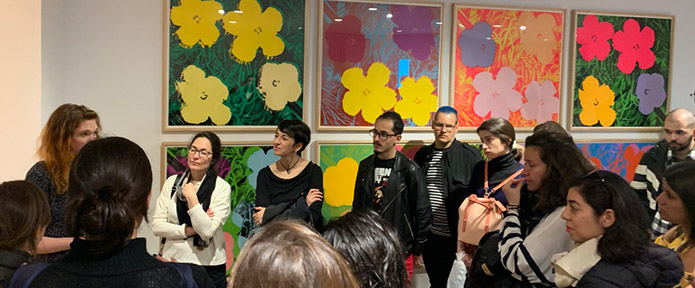Curators in the Big Apple: a journey to discover the contemporary art capital of the world
The 24 students of the first class of the Master in Curatorial Studies traveled ten days to New York, where they visited museums, galleries and other art spaces.

The city of skyscrapers, the city that never sleeps, the eternal movie set that is New York, also holds, for many, the title of world capital of contemporary art. Since the 1940s, the immense American city, home to more than 8 million people, has become the perfect place for museums, galleries and other art venues.
It is also the huge residence of an effervescent artistic and social community in which the boundaries of art are blurred and permeable to the construction of the city itself. With the interest of getting to know in situ this artistic ecosystem of planetary influences, the 24 students of the first promotion of the Master in Curatorial Studies of the Museo Universidad de Navarracuratorial studies, made a curatorial trip to the Big Apple last April.
The students, of ten different nationalities, had the opportunity to discover different art centers with curators, artists and other art professionals. During this ten-day trip, they had the opportunity to visit emblematic museums such as the Museum of Modern Art (MOMA), the Metropolitan Museum of Art (MET); Chelsea galleries such as Gagosian, Pace or Hauser & Wirth, and even to get to know public art projects promoted by the City Council .
Precisely, the first appointment they had upon landing in New York was with the MOMA's curator of Latin American art, Inés Katzstein, who explained how she develops her work, in which she seeks the dynamization of the collection, interdisciplinarity and the creation of exhibitions with a self-critical look at the museum itself.
They were also able to learn more about Latin American art from the founder and director of the Institute for Studies on Latin American Art, Ariel Aisiks (ISLAA). This is an entrepreneurial cultural project that aims to promote the history of Latin American art and support artists in their international projection.
NEW YORK PUBLIC ART
The trip also provided an opportunity to learn about different art interventions in public spaces, an aspect in which New York is a benchmark. The group met with Sergio Pardo López, from the Department of Cultural Affairs of New York City. For María Díaz Banet, a Madrid-born graduate in Art History, this was one of the most enriching experiences of the trip: "We were able to learn about the work of the Department of Culture in relation to the program for the creation of art for public space. It was also very interesting to discover how 1% for the arts works, a public initiative to promote culture and public art. It is a fascinating project with many implications". On another day they were also able to tour the Highline Park, where works, especially sculptures, are exhibited by curator Cecilia Alemani.
EXIT TO HUDSON VALLEY
On one of the days, the group went to Cold Spring (Hudson Valley), an hour from New York, where the Magazzino Italian Art is located. There they were given a guided tour by the Spanish architect Miguel Quismondo, who was in charge of the design of the current building, which houses the art collection of Nancy Olnick and Giorgio Spanu. "I really liked both his collection and the architecture of the Museum and having the chance to take the tour with the architect," explains Pau Cassany, a Catalan student who is an architect by profession. That day they also visited Dia: Beacon, a minimalist art center located two hours from New York City.
CUSTOM ROUTES
The students also enjoyed two free days to visit those museums and cultural spaces most closely related to their interests and concerns as curators. For example, they visited different artists' studios at Mana Open House in New Jersey and Dumbo Open Studio in Brooklyn, and toured the Bronx Museum, The Met Breuer, MoMa PS1, SculptureCenter in Long Island, and Isamu Noguchi Museum, located in Queens, among others. They also visited studios of artists such as Alfred Jaar, in Chelsea.
"Getting to know closely aspects and institutions of the New York art sphere has contributed substantially to my formation as a curator. I have been aware of the great multiplicity of possible points of view and lines of research," Díaz notes.
In the same vein, Cassany values the experience: "It is very important to get to know other ways of working and this trip has given us the opportunity to learn from different professionals and multiply our points of view".
In total, the students visited more than 20 museums and art centers, met with 15 professionals and visited multiple studios, as well as the residence of two private collectors. An enriching trip to a constantly developing scenario.